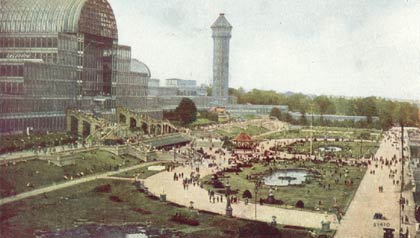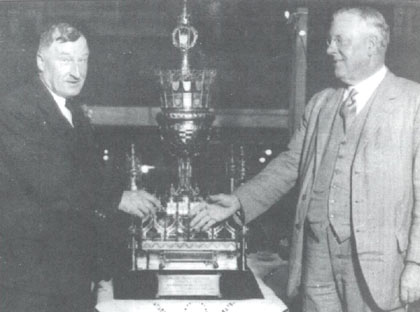National Championships of Great Britain - The 1,000 Guinea Trophy
4-Oct-2004David Caldwell looks at the intriguing history of perhaps the most famous trophy in the history of the brass band movement, which today resides in the Museum of Welsh Life near Cardiff.
We won it, we want it back.
Forget the FA Cup, the Wimbledon Salver or even the Ascot Gold Cup. Nothing compares to the magnificent craftsmanship of the Thousand Guineas Trophy.

Crystal Palace - 1924 programme
The year is 1871 and the Crystal Palace Company, which managed this famous London landmark decided to organise a five-day National Music Union Brass and Choral Event. Such an important festival demanded an important prize and a competition was arranged for the design of a trophy worthy of such an event; the prize was £50. The winning designer was architect SJ Nicholl and the contract to make the trophy was awarded to Messrs. Cox of Southampton Street London. The cost of manufacture was not to exceed one thousand guineas.
The competition organisers were wildly optimistic in their expectations of the number of entrants. They visited every city in the UK to try to drum up interest, but there was very little support for the Large Choir class 'of between 250 and 500 voices'. The reason for such poor support for that part of the competition was the vast logistical problem of recruiting and rehearsing such a large number of singers. Even in Wales, where large choirs were nothing new, the decision to enter was carried by only one vote at a meeting of some two dozen choirs in Aberdare Temperance Hall. Transportation from anywhere in the United Kingdom was not a problem as the organisers had negotiated free travel with the railway companies for all competitors. Supporters were also offered reduced fares; the first class return fare from Cardiff to London was £1, whilst second class passengers "in covered carriages" paid ten shillings.
Came the day of the competition and only one choir had entered, the 450 voices of the choir of the South Wales Choral Union, Cor Mawr, conducted by 'Caradog' whose real name was Griffith Rhys Jones, a colliery blacksmith from Aberdare. Naturally, they were deemed the winners and the magnificent trophy was theirs. They promised to return the following year to defend their title. They did and Cor Mawr was joined by just one other choir, from the London Tonic Sol Fa Association; Cor Mawr were the winners again. Their homecoming was described in the Aberdare Times of 19th July thus. "On the arrival of the train at 8.30 pm the excitement became intense. Loud cheers were given by the assembled thousands, intermingled with the bursting of fog signals, the firing of canon, and what with the ringing of bells and the playing of the bands the scene may be more easily imagined than described". 'Caradog' Jones, ever the modest hero left the train at Quakers Yard before it reached Aberdare and travelled alone to his home in Treorchy by carriage.
Cor Mawr were already preparing for the 1874 contest and would, no doubt, have won it again and the right to keep the trophy. After such a disaster in the previous two years the 1874 competition was cancelled and, despite protests over the interpretation of the rules, the beautiful silver gilt trophy was recovered from the winning choir and locked in the vaults of the Crystal Palace Company not to be seen for another 27 years.
The late 19th century was a high point in Welsh choral singing which earned them the title of 'Land of Song', but at the same time another form of amateur music-making was also very popular. There were around 3,000 brass bands in the UK. Every town and village had a brass band as well as every mill and mine. Enter the young John Henry Iles, a keen supporter of the brass band movement. He had already acquired control the weekly band magazine 'The British Bandsman' and a London music-publishing firm and set about organising a major band contest in London. The bands from the mills and mines of the Midlands were already fiercely competitive and jumped at the chance of 'coming down south' to take on the southern bands.
John Henry had some influential friends, not the least of which was Sir Arthur Sullivan. Iles and Sullivan met to discuss the Crystal Palace contest and the subject of a suitable trophy came up. Sir Arthur also had excellent connections and recollected that he had seen, on the company assets register, mention of a large trophy which was no longer in use being stored in the vaults. He gave John Henry a letter of introduction to Henry Gillman, Managing Director of the Crystal Palace Company.
Iles and Gillman met and went down into the vaults. Iles recalled afterwards in his memoirs, "Two men were there, pulling out a big box, about 4 feet square. It was of oak, and strongly bound by brass strips. It was unlocked, and when the cover was lifted, disclosed velvet-lined compartments and a great mass of silver encrusted with jewels, of wonderful workmanship. It was soon assembled, and then I found to my joy that it was just the thing I wanted. In fact it could not have been better if it bad been specially made for my purpose".
The silver gilt trophy is of Victorian-Gothic design and comprises three main parts. The Chalice alone stands 27cms high and contains filigree and repousse work, two shields represent the enamel figures of King David and Saint Cecelia. The chalice is supported on a pierced stem set with precious stones and the whole is surmounted by a coronet with various shields for the winners' names to be engraved. Both chalice and coronet stand on a 46 cm square base with open tracery and enamelled scrolls on which are inscribed verses from the Book of Psalms. Each of the four corners has a niche containing a silver figure of Aretino, Palestrina, Mozart and Handel, representing music through the ages
Cautious about organising another music competition the Crystal Palace Company were finally persuaded by Iles, to offer the Thousand Guineas Trophy as the first prize in the Championship section of the first National Brass Band Championships of 1900.
The trophy was won, against all expectations, by Denton Original Band, but the band that has its name on the trophy most is Fodens Motors Works Band under the legendary Fred Mortimer, who won it seven times. The Crystal Palace contest continued, except for the 1914-18 war years, until 1936 when the much-loved venue was completely destroyed by fire.
In 1977 the trophy, now over a hundred years old, was loaned to the Foden Band for an exhibition. It was also on display at Belle Vue, Manchester, another great brass band contesting venue, for the1980 "Granada Band of the Year Contest".
During the thirty or so years of the contest's history only one southern band has ever won the Thousand Guineas Trophy. That was the Luton Red Cross Band in 1923. This band had nothing to do with the international relief organisation but from the red cross of England's patron saint. The Bedfordshire band even wore straw boaters to emphasise the tradition of Luton's main industry of hat making. Incidentally, the night the band won the trophy the Luton Town Hall was completely destroyed by fire but there is no connection, only co-incidence.
But back to the Land of Song. Caradog's massive choir of 450 voices, made up from eleven other choirs, that won this fabulous trophy never competed again. For such a choir to still be remembered a hundred and fifty years after it ceased to exist is testament to its splendid achievement which marked the golden era of Welsh choral music. Caradog went on to conduct the famous Treorchy Male Voice Choir and died in Pontypridd on December 4th 1897.
The trophy is known in brass band circles as the Thousand Guineas Trophy or the Crystal Palace Trophy but it will always be fondly remembered in Wales as The Caradog Cup.

Fodens being presented with the trophy in 1930.
E. R. Foden receives the cup from John Henry Iles
In 1938, some sixty five years after the choral competition, the issue of the Welsh claim to the trophy, led by The Earl of Plymouth and the National Museum of Wales, was raised in both houses of Parliament and supported by several other prominent Welsh MPs and Peers. At that time the country was on the verge of war and the matter was quietly dropped. In 1952, by which time the Crystal Palace Company had folded, the trophy was transferred to the Greater London Council and again the claim of ownership was pursued. After much legal wrangling the GLC agreed, in 1972, to lend this magnificent and valuable item to the National Museum of Wales for the centenary celebrations of the original competition. Two years later the GLC offered the trophy to the museum on permanent loan and this magnificent and much travelled work of art is now the centrepiece in the music section of the Welsh Folk Museum's, Gallery of Material Culture.
Copyright David Cawdell 2004
David Cawdell started playing the euphonium in Luton temple Salvation Army band when he was eight years old. After a period with the Luton Band and the NYBB he served for some years in the Band of the Irish Guards and travelled extensively with them on concert tours in Canada, America, Australia and Europe. On leaving the Brigade of Guards he settled in Clacton on Sea where he began his conducting career, also taking over as Musical Director for several local operatic societies. Now retired from a senior management position in public relations he divides his time between his choral work and freelance writing.















